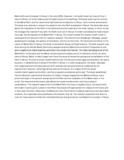| dc.description.abstract | Bahai faith was introduced in Kenya in the early ]950s. However, it is hardly
known by many of how it came to Kenya, for what reasons and the basic tenets of its
teachings. This study examines the content of the Bahai Faith, and the factors that
facilitated its introduction to Kenya - both intemal and extema1. The study is an
attempt to answer the question why the Faith is accepted in Kenya. The study also
cares about the implication of the Faith to the adherents and its meaning to the wider
society, in other words, the changes that resulted if any after the Faith took root in
Kenya. A model is developed to help analyze the origin and the spread of the Bahai
Faith in Kenya. The model is called the market model, which is composed of the
elements that the research analyzes. The elements are: Messenger, Message, people
accepting the message, the system of interaction, and the environment. The elements
contribute to the nature of Bahai Faith in Kenya.
The study involves both library and field research. The field research was done
among the Nairobi Bahai Community supplemented by Bahai Communities in Vihiga
district and some insights from Bahai teaching-activities in the outskirts of Nairobi.
The historical background of the Bahai Faith, its founders and the Bahai
narrative gives the study a point of reference. As the narrative came to Kenya, Bahai' s
history began and hence the study attempts the spread and consolidation of the Faith
in Kenya. The kind of social transformations that the narrative encourages and stands
for are also a key point in establishing the status of the Faith in Kenya.
In a wider perspective, the study -discusses how religious growth and
development both qualitatively and quantitatively is affected by the experiential
vi
element, which figuratively acts as the fulcrum of a religion while the social
transformation aspect as the effort, and the progress is considered as the load.
The study established that the (fulcrum) experiential dimension of religion,
though negated by the Bahais of Kenya, has a prominent place in the growth and
spread of the Faith and the realization of the Bahai vision in the world. The
experiential dimension also affects the social transformation and the process of
consolidation. The research asserts that if the Bahai Faith is to have a tangible future,
the experiential dimension must be given a place to the effect that people will
appropriate the religious truth freely and in their best intuitions. Otherwise, the Bahais
do have their brand of religious experience and expression whatever the magnitude
and a justification of whatever they do. The research postulates that there is room for
improvement so that the intended influence and goal can be manifested more widely
in Kenya | en |

